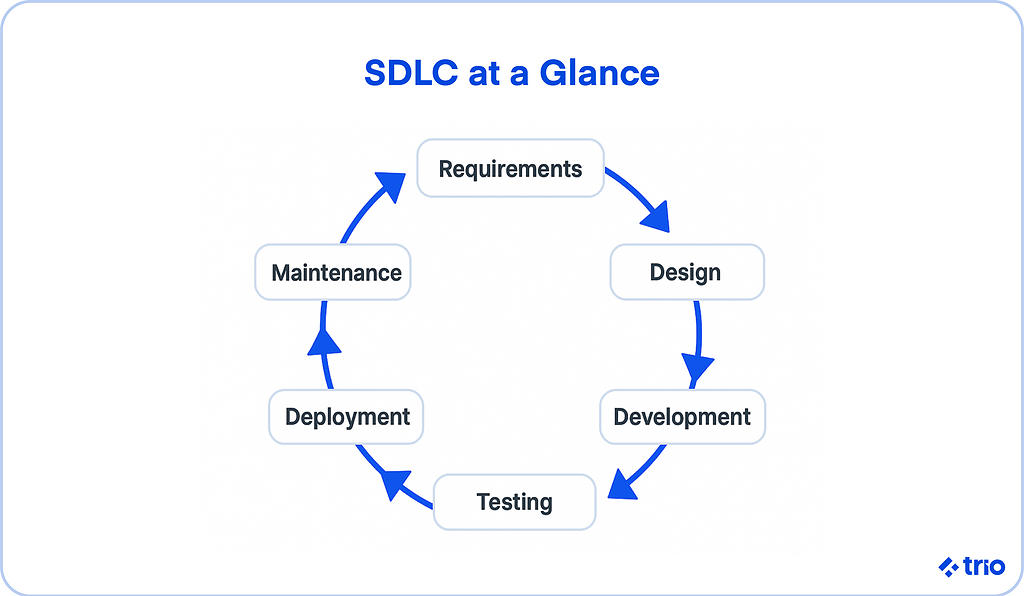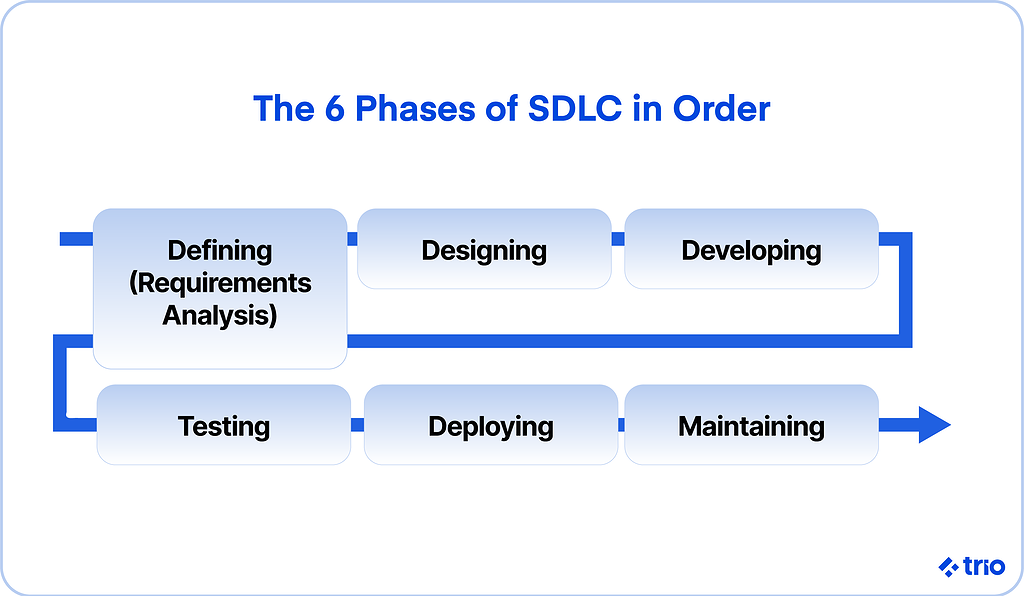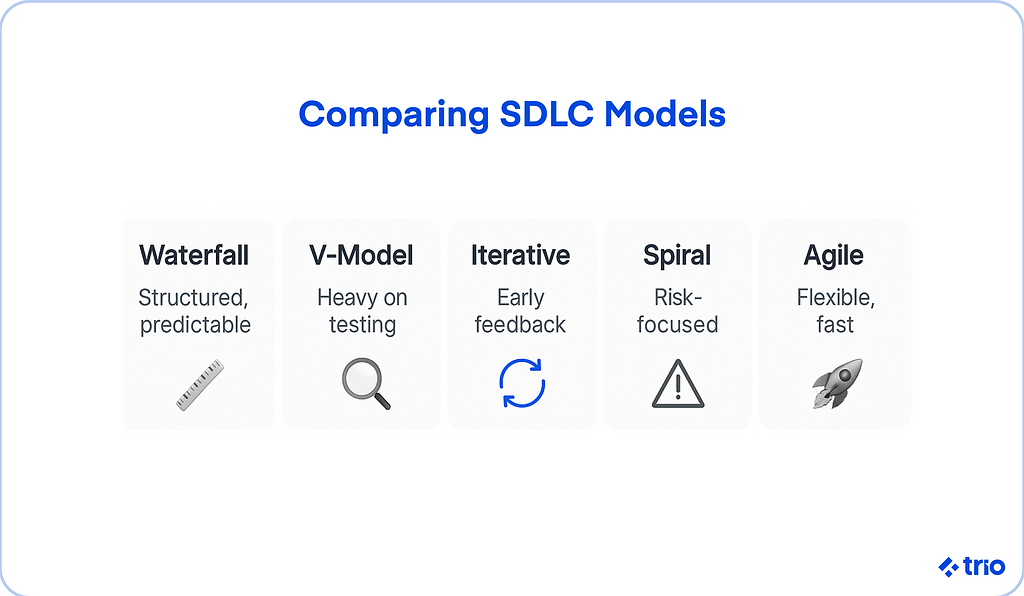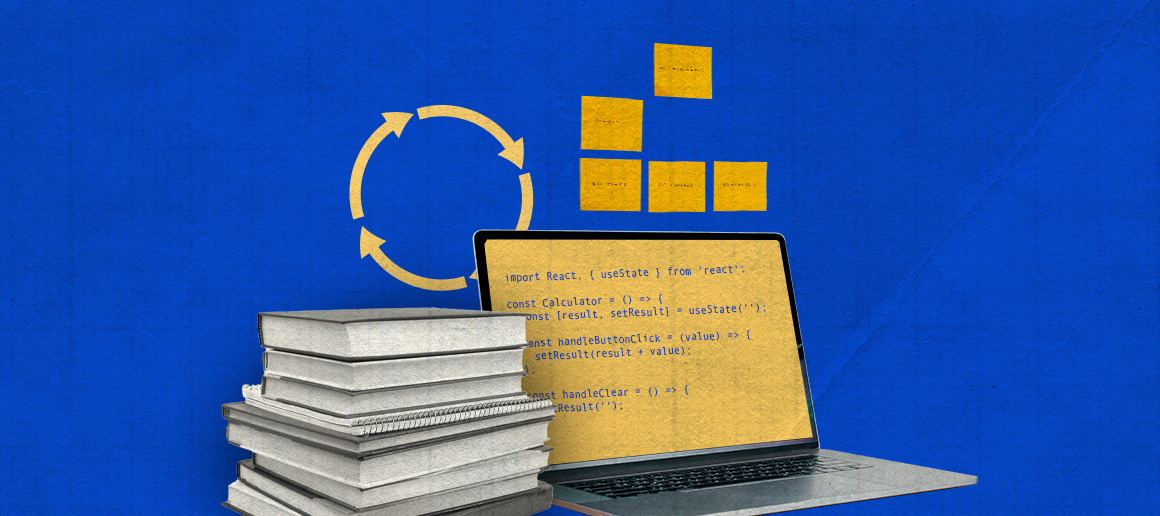Understand the Software Development Life Cycle (SDLC), a process used by the software industry to design, develop, and test high-quality software.
Those who are new to software development often don’t know where to start.
The Software Development Life Cycle (SDLC) is the structured process teams use to plan, design, build, test, and deliver reliable software. It provides a clear roadmap that turns an idea into a working application while reducing risk, controlling costs, and aligning the final product with user and business needs.
In practice, the SDLC provides teams with a structured roadmap that improves software quality, reduces project risks, and helps control costs. It ensures that business requirements, user needs, and technical constraints are aligned at every step.
As software projects become more complex, with Agile development, DevOps pipelines, and even AI-driven tools, the SDLC remains a foundation for building reliable and scalable applications.
Continue reading to learn more about the Software Development Life Cycle (SDLC)!

Are you ready to start your development project?
We have the developers you need to take your development project in the right direction.
Companies are proven to grow their business faster with Trio.
What is the Software Development Life Cycle? SDLC Definition
The Software Development Life Cycle (SDLC) is the structured process teams use to plan, build, test, and deliver reliable software.
It’s a repeatable framework that helps transform ideas into working products while reducing risk and keeping costs under control.
The concept isn’t new. Early models like Waterfall approached SDLC in rigid, sequential phases. Over time, the process evolved into more flexible, iterative approaches such as Agile and DevOps, where phases overlap and feedback is continuous.
Think of SDLC as the map for software development. It provides both developers and businesses with a way to ensure that every project results in software that’s efficient, dependable, and aligned with both user needs and business goals.
The 6 Phases of the Software Development Life Cycle (SDLC Flowchart)
The phases of the Software Development Life Cycle take place in chronological order.
In each stage, a specific objective must be met before moving to the next.
Of course, once your app is fully developed and released onto the market, it’s your job to do the upkeep.
Let’s cover the six stages/phases of the Software Development Life Cycle (SDLC).

1. Defining
Also called requirement analysis, defining project requirements is the most critical stage of the SDLC.
Senior members of the team gather inputs from your client, the sales department, market surveys, and domain experts in the industry.
This information determines how you will make software that is profitable and sustainable.
At this stage, quality assurance (QA) and risk identification also occur.
A technical feasibility study is used to define the various technical approaches that will help to develop the project and minimize possible risks successfully.
Once the requirements have been clearly defined and documented, the client must give their final approval before moving forward.
In some versions of the SDLC, a planning stage precedes this phase, where business goals and prerequisites are examined and specified.
Modern practice: Many teams use tools like Jira or Confluence to document requirements and involve cross-functional stakeholders early. A common pitfall is gathering requirements only from management, which can lead to missing out on end-user needs.
2. Designing
A software requirement specification (SRS) is a detailed reference that expands on the functional and non-functional requirements of the given software.
Developers use the SRS as a guide to delivering the best possible product architecture.
Based on the requirements specified in the SRS document, software architects use a system design specification (SDS) or design document specification (DDS) to suggest design ideas.
Stakeholders choose the optimal by taking several factors into account, such as risks, modularity, and budget.
In practice, design may also include UI/UX prototypes (using tools like Figma or Sketch) and database schemas. A key risk here is over-engineering, which can slow development and inflate costs.
3. Developing
Here, the product is developed according to the DDS. With clear and detailed specifications, developers shouldn’t run into any significant problems while programming.
Software engineers follow the programming guidelines defined by their organization and adapt their work to the project requirements.
Different high-level programming languages are used to create the software, depending on the technology stack most suitable for the software being built.
Development is often supported by version control (GitHub, GitLab), CI/CD pipelines, and automated build systems. Agile teams work in short sprints, delivering small increments. Common pitfalls include scope creep and inconsistent coding standards.
4. Testing
In reality, this stage occurs at all stages of the SDLC.
This is where product defects are reported, tracked, fixed, and re-tested until the product reaches the standards defined in the SRS.
Essentially, this phase serves as a filter for all possible functionality errors that arise before the software’s release.
Testing now typically includes automated unit tests, integration tests, and user acceptance testing (UAT). Tools like Selenium, JUnit, and Cypress are widely used.
A modern best practice is shift-left testing, meaning tests begin early in the development cycle rather than waiting until the end.
5. Deploying
Your product is now ready to be released onto the market. Sometimes product releases happen in stages, depending on the business strategy of the client’s organization.
Usually, the product is first released to a limited audience before being tested in a real business environment.
Given relative feedback, the product may then be released in whole or undergo a round of changes to better meet market requirements.
Modern deployment often uses continuous delivery or continuous deployment pipelines, supported by tools like Docker, Kubernetes, or AWS CodeDeploy.
Releases may follow canary or blue-green strategies to reduce risk. A common challenge is insufficient rollback planning in case of failure.
6. Maintaining
After the product is released to the market, it should be maintained and updated when needed.
The development process rarely, if ever, stops at deployment.
There is a continuous need for innovation that demands your software to grow and develop with the market.
Maintenance includes bug fixes, security patches, and feature updates.
Many teams track ongoing issues through monitoring tools like Datadog or New Relic. Neglecting this phase leads to technical debt, security vulnerabilities, and customer dissatisfaction.
Software Development Life Cycle Methodologies
Various software development life cycle methodologies can streamline the software development process.
Each process model follows a series of steps unique to its type to ensure success.
Below are the most common SDLC methodologies:

Waterfall model
All requirements are defined in the beginning. Development is done in sequential phases.
Once a phase is complete, you move on to the next one. There is no going back to make changes to the previous phases.
Pros: Clear structure, easy to manage for small projects.
Cons: Inflexible; poor fit for changing requirements.
Iterative model
This model relies on a working prototype developed early on, wherein every stage, your developer team must go through the motions of setting requirements, testing, and so on.
Complexity and additional features are added progressively throughout the process.
Pros: Allows for early feedback; risks can be discovered sooner.
Cons: Can increase costs if iterations multiply.
Big Bang model
The Big Bang model, unlike other popular models, does not follow any specific set of guidelines.
You’ll be able to jump right into development when you follow this mode, but it’s a gamble as to whether or not you’ll please your clients.
Pros: Fast start; minimal planning.
Cons: High risk of wasted effort if client needs are misunderstood.
V-shaped model
Like the waterfall model, this model transitions directly from one phase to the next upon completion of each phase.
However, the V-shaped model is characterized by a period of testing that takes place at each development phase.
Pros: Emphasizes verification and validation.
Cons: Still rigid; limited flexibility for changes.
Spiral model
The spiral model is similar to the waterfall model, but with a greater emphasis on risk analysis.
This process is iterative as new feedback is implemented following each incremental release.
Pros: Strong on risk management; flexible.
Cons: Can be expensive and complex to manage.
Agile model
This methodology is distinguished by its collaborative intent and involves a high level of engagement between the client and the developers.
It is also an iterative process completed in cycles called sprints with the objective of continuous development.
Pros: Flexible, collaborative, fast delivery of value.
Cons: Requires disciplined teams; scope creep risk if not managed.
Related read: Learn to build an agile software development team
Comparison Table of SDLC Models
To make sure that you understand all of the differences, let’s look at a side-by-side comparison.
| Model | Best For | Strengths | Weaknesses | Example Use Case |
| Waterfall | Small projects with stable needs | Simple, structured, predictable | Inflexible, hard to adapt | Banking system with fixed regulations |
| Iterative | Projects needing early feedback | Early working versions, manageable risk | Cost can rise with iterations | E-commerce site with evolving features |
| Big Bang | Very small, experimental projects | Quick start, minimal planning | High risk of failure | Proof-of-concept app |
| V-shaped | Safety-critical software | Heavy testing at each stage | Rigid, costly changes | Medical device software |
| Spiral | High-risk, complex projects | Strong risk management, flexible | Expensive, complex | Aerospace systems |
| Agile | Dynamic, fast-changing projects | Adaptive, customer-focused, rapid delivery | Needs discipline, scope | SaaS product with monthly updates |
Benefits and Challenges of the SDLC
The Software Development Life Cycle is a way to bring order and clarity to the often-messy process of building software. Like any framework, it comes with strengths that make life easier for developers and clients, as well as a few challenges to watch out for.
Why Teams Use the SDLC
There are many different reasons why you might want to use the software development life cycle.
Some of the most impactful advantages include:
- Better quality software: Each stage includes its own reviews and approvals, which help catch mistakes before they become significant problems.
- Clear expectations: Having a roadmap makes it easier to estimate time, budget, and resources.
- Lower risk: Early planning and structured testing reduce the chance of surprises late in development.
- Closer client collaboration: The SDLC keeps stakeholders involved so the final product actually solves their problems.
- Efficiency: Teams waste less time backtracking when everyone knows the process.
What Can Be Difficult
However, several disadvantages make the SDLC difficult for many companies to adopt.
Luckily, knowing about the challenges you will face in advance can help you prepare and potentially avoid most of them.
Before you make your decisions, consider:
- Not every model is flexible: Traditional approaches like Waterfall can make it hard to respond to change.
- Complex models require discipline: Spiral or Agile demand good communication and experienced teams.
- Scope creep: Without careful management, projects can balloon past their original goals.
- Ongoing effort: Even after release, maintenance and updates require steady investment.
Measuring SDLC Success
Just following the steps of the Software Development Life Cycle (SDLC) isn’t enough.
What really matters is whether the process actually helps your team deliver better software. That’s why it pays to track the signals that show the SDLC is working.
One of the most evident signs is the development speed.
If your team can move from idea to working product faster, the SDLC is doing its job. Another is defect rates: fewer bugs slipping through testing usually means requirements are precise and quality checks are adequate.
Success also shows up beyond the engineering team.
Customer satisfaction reveals whether the final product actually solves the problems it set out to address. Budget alignment is another indicator. A solid SDLC helps avoid unnecessary rework and keeps costs under control.
And don’t forget to look at developer focus. If your team spends more time building new features instead of patching old issues, the process is creating real efficiency.
The 12 Key Principles of User-Friendly Software Development
The ideal software development process balances business-oriented client needs with the need to optimize users’ interaction with the software.
Keeping the latter in mind is critical to developing software that not only performs well on the market but genuinely provides value to the user.
The end-user likely doesn’t possess the same technological expertise as your developers, so it is imperative to make your software user-friendly.
To do this, you have to understand what your end-user needs and/or what problem your software will solve.
1. Define your User
Before you start the process of software development, it is crucial to identify the key elements of your end-users’ behavior.
Ask big questions like:
- “What motivates my users?” and
- “What are my users looking for?”
2. Know your Audience
Figuring out who your key demographic is will give you a better idea of who your users are and how to adapt your software to their needs.
You should consider the following segmentations to analyze your user base:
Geographic
A user’s geography often defines economic factors, which, in turn, affect their buying potential.
You can narrow down this category as you like, from countries to counties to specific regions.
Demographic
This type of segmentation is based on factors such as gender, age, race, occupation, socio-economic status, educational level, family status, and marital status.
These demographics will influence user behavior.
Psychographic
Attitudes, values, beliefs, interests, and lifestyles all play into psychographic segmentation.
Psychographic characteristics affect a user’s decision-making process.
3. Study the Behavior of your users
Familiarizing yourself with your audience is the first step to pinpointing who your users are.
By understanding where your users are from, how they identify, and what they believe, you can gain a deeper insight into their behavior.
Software development is not limited to programming and technical attributes. It also involves understanding the human psyche and how your users’ emotions and behaviors can be addressed through your software.
4. Research your Market
Market research creates a solid base for understanding your product’s chances for success given current market conditions.
You can also identify the challenges you might face when launching the product and find solutions to overcome them while still in development.
For example, knowing your competition will give you an advantage in developing the features that they lack, setting competitive pricing, and optimizing the product to market needs.
5. Refine Your Tech
While the technical features of the software can vary, there are general guidelines that your software should follow for it to be user-friendly.
The idea is to make your product easy to use, allowing users to navigate to their goal in as little time as possible.
6. Prioritize the Simplicity
Please keep it simple.
From the installation of your software to user interaction, everything needs to be well-documented and straightforward.
Clean and minimalistic designs are the distinctive features of the most popular applications and software solutions. Simplicity allows for easy user navigation.
7. Don’t forget the Aesthetic
Whether you like it or not, your product will get judged by its cover, so it’s essential to make a good first impression.
The appearance of your software has a direct effect on its user-friendliness.
8. Be Intuitive
Similarly, a well-designed graphical user interface (GUI) will help users avoid having problems with your software.
A well-designed GUI can sometimes compensate for minor flaws in software, but by no means can it replace good programming, which will ultimately define the value of your product.
9. And Updatable
Updating your software should be a no-brainer for the end-user, as they are likely to skip the process if it’s complicated, which can lead to functionality issues.
To avoid exposing your software to potential problems, ensure the updating process is seamless.
10. The software must be Efficient
The goal of your software is to provide value to the end-user by completing its job without interfering with other programs or creating any roadblocks for its users.
It should save time for the user and help them solve their problems efficiently.
11. And easy to remove
Uninstalling your software should be just as easy as installing it.
If your software is complicated to remove, it can become a burden and complicate the performance of your users’ devices, making them less user-friendly.
Although you may not want your product to be uninstalled, the process should be fast and transparent for the end-user.
12. Provide full support
Your software needs a sound support system.
You can develop the best and most comprehensible software ever, but your end-user may still have questions.
Users should be able to contact and receive support in a fast and timely manner.
Customer service is often the most crucial element of user-friendly software.
The Future of the SDLC
The Software Development Life Cycle has been around for decades, but it’s far from outdated.
While the core idea of moving through defined stages will always be relevant, the way teams apply the SDLC looks very different today than it did even a few years ago.
One major shift is the rise of DevSecOps. Instead of bolting security on at the end, teams now shift left by baking it into every stage of the cycle. This approach makes applications more resilient and reduces the cost of fixing vulnerabilities later in the process.
Another significant change is the growing role of artificial intelligence. From generating code to automating tests, AI speeds up repetitive tasks and frees engineers to focus on design and problem-solving.
Looking ahead, AI may even help refine requirements or predict risks before a single line of code is written.
Finally, the SDLC has adapted to a world where teams are often distributed and cloud-native.
Collaboration tools, CI/CD pipelines, and containerization enable developers worldwide to work together in real time, ensuring projects move smoothly regardless of the team’s location.

Subscribe to learn more about Hiring
Trio can help you and your project!
Trio supports clients at every step of the software development life cycle.
From translating your vision into usable software to supporting your product after its release, Trio is here for you.
With Trio, you’ll experience something called Engineering Team Allocation (ETA), where Trio provides small and medium-sized businesses with exceptional software engineering talents based on your project’s size and requirements.
You get access to hard-working and highly trained professionals without the need to hire them within your company.
If you’re unsure about where to begin in the software development process, please don’t hesitate to contact us to discuss costs and future outlooks. We have the very best senior software engineers in the market.
Trio has partnered with dozens of growing businesses to speed up development timelines, improve product quality, and reduce costs. Our engineers bring both technical depth and user-focused design thinking, making sure every project aligns with real business goals.
Trio is ready to provide you with all the necessary expertise required to build a user-friendly and highly functional software.
Tell us about your project and start developing today!
FAQ
How is SDLC different from Agile?
The difference between SDLC and Agile is that SDLC outlines the full lifecycle, while Agile is one way of executing that lifecycle with flexibility. Agile sits inside the SDLC as an iterative methodology.
Why is the SDLC important?
The importance of the SDLC is that it provides structure, reduces risk, and ensures teams don’t skip critical steps. It helps deliver predictable, high-quality software.
Which SDLC model is best?
The best SDLC model depends on your project’s stability, complexity, and need for flexibility. Waterfall fits fixed requirements; Agile suits evolving ones.
What is the first step in the SDLC?
The first step of the SDLC is the requirements phase, where teams define goals, constraints, and expectations. This stage guides every decision that follows.
What are the phases of the Software Development Life Cycle?
The phases of the SDLC move from Defining to Designing, Developing, Testing, Deploying, and Maintaining. Some teams expand or rename steps, but the flow remains similar.
Is SDLC used in Agile development?
The role of the SDLC in Agile is that Agile repeats the same lifecycle stages in short, iterative cycles. The structure stays the same; the cadence changes.
What is the purpose of SDLC documentation?
The purpose of SDLC documentation is to keep requirements, decisions, and specifications crystal clear for the whole team. It prevents miscommunication and supports future updates.





